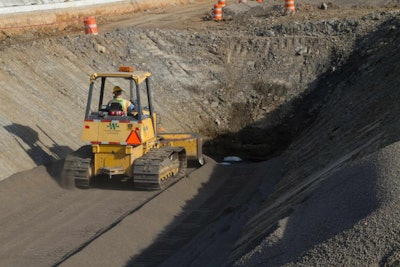 An average of 10 trucks a day delivered loads of the expanded clay lightweight aggregate. (Photo: Trinity Lightweight)
An average of 10 trucks a day delivered loads of the expanded clay lightweight aggregate. (Photo: Trinity Lightweight)The final segment of work required connecting Corridor X, soon to be known as I-22, with I-65 in Birmingham, Alabama, presented unseen challenges. The Corridor X interchange begins northwest of I-65 and extends southeast of I-65 to U.S. 31. The interchange is complex geometrically, with four levels and nearly 20 bridges, and traffic is busy on I-65, requiring extra lanes. Finally, the environmental factors are sensitive and several utility lines run through the area, including an existing concrete drainage system that must shoulder the weight of the new traffic lanes.
The finished interchange construction project will complete Alabama’s 96-mile portion of the Birmingham-to-Memphis Interstate 22, and connect it to I-65. “Construction of the interchange is the largest and most expensive project the Alabama Department of Transportation (ALDOT) has awarded in more than 40 years,” says ALDOT spokesperson Tony Harris.
Construction began in August 2010, and is now nearing completion in November 2015, according to reports from Gary Smith, construction engineer with the Alabama Department of Transportation.
As with all projects of this magnitude, there are challenges that arose along the path to completion—some of which lie below the surface. In the case of Corridor X, one such challenge was addressed with a resourceful approach.
Blasting Ahead
Contracted to Atlanta, Georgia-based Archer Western, much of the initial work required blasting, drilling and hauling away rock, before construction could begin. According to Michael Chance, one of two Archer Western civil superintendents on the job, the crew performed a mass excavation of dirt and rock required to extend the six-lane highway to eight lanes—four in each direction.
“The big trial for the crew was the amount of rock; this includes drilling and blasting 1.9 million yards of material that also have to be moved on site,” Chance says. “It was challenging to coordinate trucks and operations to keep production on track.” Still, he and his team forged ahead with a good measure of excavation ingenuity, unearthing and realigning the groundwork phase by phase.
Chance was in charge of all grading and underground utilities, including storm sewers, water lines, guard rails, and proper signage. Archer Western also had two bridge superintendents and a senior superintendent overseeing the work. Upon completion, the four-level interchange will measure 85 feet tall and span 1.5 miles long, including 18 bridges and five ramps.
Under Pressure
The project’s groundward challenge and, ultimately, its engineering feat, came into play with an existing concrete drainage system that runs north of the interchange, along 1-65 and I-31. The system drains storm water runoff for hundreds of acres along the highway, so it is a crucial part of the infrastructure that must be protected.
Widening of the road required construction of two new traffic lanes, which would be built over portions of the drainage system, where half of the drainage system’s box culvert would be under traffic and the other half would face the adjacent slope. ALDOT wanted to ensure the box culvert, some 25 feet underground, would be cushioned from the load – the material covering the culvert, the new roadway, and the weight of eventual traffic.
In three, 250-foot-long spans, the team had to excavate down to the box culvert, inspect it for damage and cracks, wash it off, and cover it with a black membrane and adhesive to seal it. Then, fill material was necessary to bring the area back up to grade and accommodate the load. The problem was in that the weight of ordinary soil and fill material, plus the weight and wear-and-tear of traffic, could cause the box culvert to be over-stressed and potentially crack.
Engineers determined the use of an expanded clay lightweight aggregate as a fill material, at half the weight of ordinary fill, to replace more widely used material like ordinary soil, sand or gravel. “Getting the gradation down to the necessary weight was an issue for the local aggregate supplier in Birmingham,” says Chance. A lighter weight specification was necessary, which he determined was possible with the use of Riverlite, a lightweight aggregate manufactured by Trinity Expanded Shale and Clay (ESC).
“Our requirement was to get the weight of the lightweight aggregate down to 77 pounds per cubic foot,” Chance says. “The Riverlite fill took all of the direct weight and pressure off the top of the culvert.” In fact, the LWA fill was well below the design density, with compacted densities of less than 60 pounds per cubic foot.
Rotary kiln-produced expanded clay lightweight aggregate has been effectively used for almost 50 years to solve geotechnical engineering problems and to convert unstable soil into usable land. The aggregate used in this geotechnical application is manufactured by Trinity ESC.
“When we mine our clay, we bring it into a shed to control the moisture,” explains Jeff Speck, Trinity ESC’s manager of sales. “We process it by heating it to about 2000°F in a rotary kiln. After it cools, it’s no longer clay. It’s a ceramic, hard, inert aggregate, thus, being structural and very tough. After the material cools, we crush, screen and grade it to customer specifications.”
Protecting a concrete pipe or culvert from being damaged by weight is a relatively new application for the product. “Corridor X is only the second project of this type for which we’ve supplied Riverlite for fill over the top of a pipe that’s buried deep beneath a highway. It’s a strategic application of lightweight aggregate because it reduces the load on the pipe or box culvert by more than half, as compared to normal weight material,” Speck says. The aggregate has very low density and an extremely high angle of internal friction; thus, the pressure is greatly reduced.
Up to Grade
An average of 10 trucks a day delivered loads of Riverlite from the Livingston facility, about two hours south of the jobsite. Because it is lightweight, coarse and non-compacting, Archer Western was able to backfill the trench with a straight mix, directly on top of the membrane-covered culvert, without having to use any equipment to tamp it down. In four-foot lifts, the crew placed 15,000 cubic feet of the aggregate, bringing the trench within two feet of ground level, then covered it with an 18-inch layer of compactable material, followed by four inches of topsoil on top.
After two weeks of placement, the culvert was again deep underground and the crew set to work paving the filled-in trench. For Chance and his crew, next steps involved backfilling the last section of the culvert, approximately 800 feet further south, and putting this section of the project in the rearview mirror.
In the coming weeks, tons of traffic will travel over the area, with drivers never aware what lies beneath the surface and the requirements that make new lanes like these a reality.
With the completion of Corridor X right around the corner, the planned easier access to and from Memphis, a cargo and logistics hub, should perform well for the local and regional economy, and open northwestern parts of the metropolitan area for development growth.
Editor’s Note: Laura Drotleff and Don Eberly are with Eberly & Collard Public Relations, a national firm specializing in research, writing and marketing within the design, architecture, building, and engineering industries.










